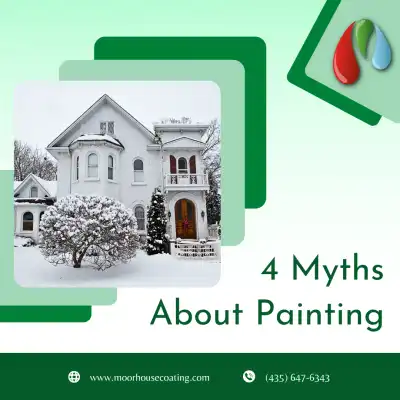4 Myths about Painting
Jason Moorhouse

Busting myths about interior painting can help homeowners make more informed decisions when it comes to refreshing their living spaces. Here are four common myths often encountered by professional painting contractors, along with the truths behind them:
1. Myth: High-Gloss Paint is the Best Choice for All Rooms
- Truth: While high-gloss paint is durable and easy to clean, making it a good choice for high-traffic areas or spaces prone to moisture (like kitchens and bathrooms), it’s not necessarily the best choice for all rooms. High-gloss finishes can highlight imperfections in walls, so for living rooms and bedrooms, a matte or eggshell finish might be more suitable. These finishes provide a softer look and can help hide wall blemishes.
2. Myth: You Don’t Need to Prepare Surfaces Before Painting
- Truth: Proper surface preparation is crucial for achieving a high-quality paint job. This can include cleaning the walls, repairing holes or cracks, sanding rough areas, and applying primer. Skipping these steps can lead to paint peeling, bubbling, or not adhering properly, resulting in a finish that looks unprofessional and may require more frequent touch-ups or redoing.
3. Myth: The Paint Color on the Swatch Will Look Exactly the Same on Your Walls
- Truth: The color of paint on a swatch can look quite different when applied to a large area and viewed under different lighting conditions. Various factors, including natural light, artificial lighting, and surrounding colors (from flooring, furniture, etc.), can influence how a paint color is perceived. It’s always recommended to test a color in your space by applying a small sample on the wall and observing it at different times of the day.
4. Myth: One Coat of Paint is Always Enough
- Truth: While some paints advertise “one-coat coverage,” the truth is that achieving a uniform and fully saturated color often requires at least two coats. This is especially true when painting over a darker color with a lighter one, or when aiming for a finish with depth and richness. Additionally, multiple coats ensure better durability and longevity of the paint job.
Professional painting contractors emphasize the importance of considering these truths to avoid common pitfalls and ensure a successful interior painting project. Understanding the realities behind these myths can lead to better decision-making and ultimately, a more beautiful and satisfying outcome.
